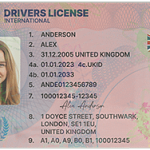Understanding Real ID: A Foundation for Modern Identity Checks
Real ID refers to a set of security standards applied to state-issued driver’s licenses and identification cards. Enacted through the REAL ID Act of 2005, this federal mandate aims to create consistent, tamper-resistant forms of identification. These IDs are designed to meet stricter criteria for document validity, including enhanced security features like holograms, barcodes, and embedded chips. As of May 7, 2025, a Real ID-compliant license or ID will be required for domestic air travel and access to certain federal facilities, making it a critical tool in national security and daily life.
Unlike standard state IDs, Real IDs demand additional documentation during application. Applicants must provide proof of identity (e.g., birth certificate), Social Security number, two proofs of residency, and evidence of name changes if applicable. This multi-layered verification process reduces the risk of identity fraud, a concern that directly impacts both public safety and law enforcement operations.
Local Law Enforcement: The Frontline of Real ID Verification
Local law enforcement agencies play a pivotal role in ensuring Real ID compliance. Officers interact with these IDs daily during routine traffic stops, community checks, and emergency responses. Their ability to quickly and accurately verify an ID’s authenticity helps prevent crimes like identity theft, fraud, and even acts of terrorism.
### Routine Interactions and Verification Scenarios
During a typical traffic stop, an officer may request a driver’s license. With Real ID, they now encounter IDs with distinct physical markers (e.g., a star in the top-right corner indicating compliance). Officers are trained to recognize these features, as well as signs of alteration, such as mismatched fonts, faded holograms, or inconsistent barcode data. For example, a counterfeit Real ID might lack the microprinting found on legitimate cards, a detail officers learn to spot through specialized training.
### Collaboration with State Agencies
Local police departments often work closely with state motor vehicle departments (DMVs) to share information about fraudulent IDs. If an officer suspects an ID is fake, they can cross-reference its details with state databases. This collaboration ensures that even if a counterfeit passes initial visual checks, digital verification through secure systems can flag inconsistencies.
### Emergency and Public Safety Applications
In emergency situations—such as natural disasters or missing persons cases—Real IDs streamline identity confirmation. First responders can use the embedded data to quickly access an individual’s emergency contacts or medical history, a capability that standard IDs may not provide. This efficiency can be life-saving in critical moments.
Tools and Training for Effective Verification
To support their role, local law enforcement agencies rely on specialized tools and ongoing training. These resources ensure officers stay updated on the latest security features and verification techniques.
### Technology in ID Checks
Handheld scanners are now common in police departments. These devices read the barcode or RFID chip on Real IDs, extracting data like the cardholder’s name, date of birth, and issuance date. This information is then cross-checked against state databases in real time, allowing officers to confirm validity within seconds. Advanced scanners can also detect tampering by analyzing the ID’s material composition, such as the presence of counterfeit laminates.
### Training Programs
Many states offer certified training courses for law enforcement focused on Real ID verification. These programs cover:
– Physical inspection of security features (e.g., UV-reactive ink, laser-engraved images).
– Use of digital verification tools and database access protocols.
– Recognition of regional variations in state-issued IDs, as each state may incorporate unique design elements while meeting federal standards.
– Handling scenarios where an individual presents a non-compliant ID, including educating the public on renewal requirements.
Challenges in Real ID Implementation for Law Enforcement
Despite its benefits, Real ID implementation presents unique challenges for local law enforcement. These hurdles require adaptive strategies to maintain effectiveness.
### Public Confusion and Misinformation
Many residents remain unaware of Real ID requirements, leading to confusion during interactions with police. For example, an individual may present a standard ID, not realizing it will soon be invalid for air travel. Officers often find themselves in the position of educators, explaining the need for compliance and directing people to DMV resources.
### Variability in State Compliance
While all states are required to issue Real IDs, the timeline and design specifics vary. An officer in a state that adopted Real ID early may be familiar with its features, but when interacting with out-of-state IDs, they must quickly adapt to different security markers. This variability can slow down verification processes if officers lack up-to-date information on other states’ ID formats.
### Resource Constraints
Smaller police departments may face budget limitations when acquiring verification tools or funding training. Handheld scanners, for instance, can cost hundreds of dollars per unit, and statewide training programs may require officers to take time away from patrols. These constraints can create gaps in verification capabilities, especially in rural areas.
### Fraudulent ID Evolution
Criminals continuously develop new methods to counterfeit Real IDs. As security features improve, so do the techniques used to replicate them. Officers must stay ahead of these trends, which demands regular training updates—a challenge for agencies with limited training budgets.
### Privacy Concerns
Some individuals express discomfort with the increased data collection required for Real IDs. Officers may encounter resistance when explaining the need for additional documentation, requiring them to balance enforcement with public trust-building.
Common Problems and Solutions in Real ID Verification
To address these challenges, law enforcement agencies and communities have developed practical solutions. Below are five common issues and actionable steps to resolve them:
#### Problem 1: “I Don’t Know Which Documents I Need for a Real ID”
Many applicants struggle to gather the correct paperwork, leading to repeated DMV visits.
*Solution:* State DMVs now offer online checklists and document validation tools. Officers can direct confused residents to their state’s DMV website, where interactive guides list required documents (e.g., original birth certificate, Social Security card). Some departments even host community workshops with DMV representatives to assist with paperwork.
#### Problem 2: “My Out-of-State Real ID Doesn’t Look Like the Ones Here—Is It Valid?”
Variations in state ID designs can cause officers to question validity.
*Solution:* The Department of Homeland Security (DHS) maintains a public list of compliant states and ID samples. Police departments can distribute laminated reference cards to officers, featuring images of Real IDs from all states. Additionally, digital tools like the DHS REAL ID Checker app allow officers to verify out-of-state IDs by scanning or entering the card number.
#### Problem 3: “The Scanner Isn’t Working—How Do I Verify Manually?”
Technical issues with scanners can delay checks, especially in remote areas.
*Solution:* Training programs emphasize manual verification steps. Officers learn to inspect security features like:
– A vertical or horizontal hologram that shifts color when tilted.
– Microprinting (tiny text visible only under magnification).
– A laser-engraved photo that feels raised to the touch.
Departments also carry backup tools, such as UV flashlights to reveal hidden patterns, ensuring verification isn’t dependent on technology alone.
#### Problem 4: “I Think This ID Is Fake, but I Can’t Prove It”
Suspected counterfeit IDs require evidence to take action.
*Solution:* Law enforcement can submit questionable IDs to state forensic labs for analysis. These labs use advanced techniques, like chemical testing of inks and material composition checks, to confirm fraud. Officers are trained to safely confiscate suspicious IDs and document the circumstances (e.g., where the ID was obtained, any inconsistencies noticed) to support lab investigations.
#### Problem 5: “Residents Refuse to Get a Real ID—What Do I Do?”
Some individuals resist compliance due to privacy concerns or misinformation.
*Solution:* Community outreach is key. Officers participate in town hall meetings to explain Real ID’s purpose (enhancing public safety, not mass surveillance) and address fears. Departments also share success stories, such as how Real ID helped solve a local identity theft case, to demonstrate its value. For those hesitant about data collection, officers highlight that Real ID data is protected under state and federal privacy laws, with strict limits on access.


